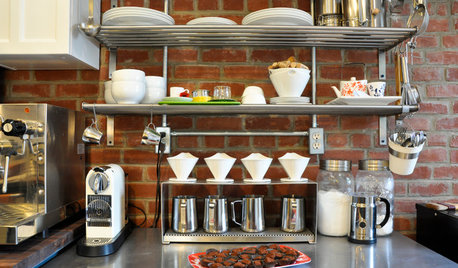cooling down the pressure canner
I have the biggest presto pressure canner.
It is hot outside and we don't run the AC much, so I want to can at night. Thing is, once I go through all the steps to heat up (on my stupid glass top range, very slow) vent steam, pressurize the canner, let it go the allotted time, and then it is time to remove it from the burner and depressurize, by that time I want to go to bed!
Is it OK if I just pull the canner off the burner when it is "done", and let it cool down on it's own overnight and just take the jars out in the morning? Or do I really need to open it once it is depressureized and cooled? I am so scared to deviate from the instructions!
Comments (76)
ksrogers
15 years agolast modified: 9 years agoThe latest Presto has two kinds of vents. One is weight of light weight aluminium and will rise to lock the lid under ANY pressure. The other is an open ended tube that the regulating weights are placed over. Lifting off and removing the weight(s) will open the inside to air. Sticking lids are more likly from a dry rubber seal gasket. If you applied alight coat of vegetable oil, the cover slides on very easily and comes off the same way. Experience with a specific design and examining it for any kinds of engineering flaws was my business at one point in my life. I must say that Presto has designed this canner for almost monkey to work it.
Here, I work with vacuum in my canning and its done with a true vacuum pump (not that weak Food Saver one!). I would never be able to open one of my container vessels that are under vacuum, unless it was vented first. These conatainers hold a vacuum for more than a year at a time, and are mostly either canning jars with traditional lids or all plastic FS containers. For one clear FS rectangular container (comes with a grater and white plastic dome cover) I have cracked four of them the first time they were put under my vacuum pump. The design of these clear plastic canisters is such it just will not work with a vacuum stronger than what a FS machine can produce. Luckily, the all round ones work just fine.zeuspaul
15 years agolast modified: 9 years agoI have four pressure cookers. Two of them are pressure canners. Three of them are obviously open to the atmosphere with the weight removed. There is no way they would hold a vacuum with the weight removed. My latest (Kuhn Rikon) pressure cooker (also canner per manufacturer but I wouldn't can with it) has no weight. I don't fully understand how it works. It is possible that this pressure cooker could hold a vacuum. I simply don't know.
Question to the forum.
How many experts, novices or seasoned canners use the pressure canning cooling procedure referenced in Linda Lou's (who I do consider an expert) post?
***8) When processing time is completed, remove canner from stove. Place on separated bricks or boards at floor level to allow air to circulate under and around canner (do not place in draft).***
Does Linda Lou teach this method? It seems to be the expert's expert method of proper cooling. I am not questioning Linda Lou as I hold her expertise in high regard. I am questioning her referenced expert.
On the floor? on bricks?? away from drafts?? Is this an example of experts gone awry? Or is this the way everyone does it and I am the only one who doesn't?
Zeuspaul
Related Professionals
Accokeek Landscape Architects & Landscape Designers · Havre de Grace Landscape Architects & Landscape Designers · Euclid Landscape Contractors · Fort Mill Landscape Contractors · Middletown Landscape Contractors · Miller Place Landscape Contractors · Mission Bend Landscape Contractors · Oxnard Landscape Contractors · Pleasant Hill Landscape Contractors · Eastlake Landscape Contractors · Clarksville Roofing & Gutters · East Norriton Roofing & Gutters · Golden Valley Roofing & Gutters · Wilmette Roofing & Gutters · Campbell Driveway Installation & Maintenanceksrogers
15 years agolast modified: 9 years agoI think that refers to the ideal situation. ONce the canner heat is removed, I just slide it to the burner thats off next to it, and let it sit there. String drafts are not good for hot canning jars, as it can cause stress and cracks. A canner being cooled off by a strong draft would have un-equal temps inside that might cause problems. When I pull a vacuum on a liqid in a jar, that was just filled from a boiling pot, that liquid will start to boil again- furiously inside! Love physics..
readinglady
15 years agolast modified: 9 years agoAs I mentioned earlier, sources I read indicated that flat sour isn't well understood. At least, not compared to something like botulism. Botulism kills, flat sour doesn't, so it's no surprise where the priority has been in terms of research. Flat sour has been emphasized more with commercial canning because it is a huge loss when a whole run of product has to be discarded.
It is, apparently, extraordinarily resistant to heat, and though nothing I read [yet] specifically said it, I inferred that in some instances it can survive what botulism spores won't. Perhaps its rarity in home canning is a tribute to the research of the USDA, the NCHFP and others. Follow the recommendations and it's highly unlikely to occur.
But I'm not an expert. I'm just a home canner who does what a lot of amateurs do. I like to know the "whys" of things. There's a wealth of information on the internet; it's a rich resource. I mean professional journals, food technology sites, etc. Many of them are accessible to anyone and it can be an interesting journey to read some of them. But then that's an English teacher and librarian speaking. I know it's not everyone's cup of tea.
Certainly there are still many variables in home canning. The product itself is the first. Tomatoes can vary tremendously in pH. The variety, the growing conditions, degree of ripeness when picked, presence of disease, all these can raise or reduce pH.
Then you add altitude, differences in pressure canners - volume, for instance - where the jars sit when they're removed, the space between them, etc. etc. and the variables are endless. Tested processing times and procedures are designed to produce the safest, highest quality product possible under the widest range of conditions.
But people are still going to do what they do. I would venture to guess canning in this generation attracts a certain percentage of people of independent spirit. We don't like being told what to do, even when it's in our interest. Add to that a distrust of government (and science) and you see where you end up.
I personally don't see the relevance of HRT (hormone replacement therapy) in this instance. I don't know of any USDA recommendation re home canning that's been shown to be erroneous or injurious.
In fact, the USDA has been very much on the mark. As early as 1926 they said low-acid vegetables and meats needed to be pressure-canned, yet I know there are still people today who can green beans in a water bath because that's what Grandma (and Great-Grandma and Great-Great-Grandma) did.
Medical research in recent years has a largely commercial (i.e. pharmaceutical companies) component; I don't know that the USDA or Extension agencies derive the same "benefit".
I experienced flat sour in one batch of tomatoes many many years ago. I hate thinking of all the work I put in only to go to the shelves that winter and discover they had to be thrown out. Why did it happen? I don't know.
But one thing I did learn from that - when I can multiple batches, I now label jars by batch so that if there's a problem with one, I can identify which jars come out of the same load. Of course, LOL, that problem has not repeated itself, but I still think the practice is a good one.
I have also experienced the "stuck lid" phenomenon. Never with the Presto but with the All-American. That's when I discovered my old shovel-shaped ice cream scoop is perfect for breaking the vacuum. If we ever quit using it for ice cream, it goes in the canning supplies!
Obviously if Presto says at the worst take it to an auto shop and put it in the vise, they've run across the problem with reasonable frequency. The newest generation of Presto canners, thankfully, doesn't present the same challenge because a portion of the gasket is exposed, so it's easy just to pull it out and break the seal if required.
Carol
greenhouser
15 years agolast modified: 9 years agoTo: digdirt
"Even after over 40+ years of home food preservation I don't consider myself qualified to dispute them with any validity. So until my credentials match those of Elizabeth L. Andress, Ph.D. and Anne L. Sweaney, Ph.D., I'll defer to their research and will advise others to do so as well."
For one thing Dave, these two "experts" are not on this Forum. Another is I saw blind faith like yours cost women their lives. None of us questioned the experts and some of us are now deceased. I wont even get into the "experts" who, after treating stomach ulcers for years with "this and that" finally disoverd they were wrong and bacteria caused ulcers.
No one is advocating leaving cans to cool over night but it happens and I have yet to hear of any deaths caused by the food that cooled slowly overnight.
Water bath canner vacuumed sealed and can't pry the top off? Try drilling a tiny hole in the lid or as someone else suggested, try reheating the canner.
A pressure canner can't vacuum seal itself because the weight isn't sealed with rubber.
greenhouser
15 years agolast modified: 9 years agoTo: Zeuspaul
You are wise to follow that path. Question everything and your questions are good ones. It just isn't wise to take anything on blind faith because someone is considered an expert.
"The problem with that theory is even experts differ. Also how does one determine who is an expert?"
Indeed the experts differ. I Googled the "canner cooling" issue and found nothing of merit worth saving and little worth repeating. Most agreed not to rush the canner to cool with no mention of some heat loving bacteria fouling the food if cooled too slowly. So what one may consider cooling too quickly another may consider cooling too slowly.....
zeuspaul
15 years agolast modified: 9 years agoA thought on the stuck lid issue. There would be no vacuum in the canner with the weight removed. However there may be some porosity in the gasket and/or the sealing surface. One might postulate that a vacuum could form at the sealing surface between the rubber gasket and the metal.
Reading Lady indicates there hasn't been much research on the sour issue. Couple that with the borderline absurd cooling procedure at Colorado State and one might conclude that the experts don't know!! The cooling procedures seem to be based on speculation!
Canning jars can handle rapid temperature changes. You can pour hot water in them and they won't crack. They can also handle rapid cooling. If one were to design a cooling off one might assume a dunk in cool water shortly after removal from the canner. I am no expert but if slow cooling is a problem then my proposed procedure would address it better than anything I have read.
It seems that one should depressurize slowly and then cool quickly. Depressurize seems to be well accepted and based on science. Cool quickly seems to be speculation.
Zeuspaul
readinglady
15 years agolast modified: 9 years agoCanning jars can handle rapid temperature changes. Sometimes.
That's why the bottom of jars falls out in canners. It's called thermal shock. Personally, I wouldn't risk it.
As far as flat sour or any other spoilage/quality issue is concerned, having worked in the lab of a cannery during my college years, I decided long ago to follow as closely as I can industrial standards. Leaving product in a canner overnight isn't one of them.
But canning, as with other home avocations, offers us the opportunity to decide for ourselves what our "canning philosphy" is. That includes our tolerance for risk. Some risks are low; some are high. Many decide, with good reason, to accept low risk for the sake of convenience.
On the cooling issue itself, I am no expert. I do know as far as Extension sites are concerned, much of the writing is poor; a failure to be explicit doesn't mean evidence is lacking. I would recommend anyone concerned direct questions to Dr. Elizabeth Andress of the NCHFP or Dr. Angela Fraser at North Carolina State. Perhaps they can reference appropriate research. If not, at least we'll know.
As for myself, unless I drop off, I still have no plans to leave product in the canner. I can't see any benefit (even if it's merely a quality issue) in leaving it stewing.
The nice thing is, we get to decide those things for ourselves.
Carol
greenmulberry
Original Author15 years agolast modified: 9 years agoWhat an informative thread! Well just for the record I am convinced not to can unless I have time to let it cool down properly following the instructions. I really don't want to have to worry about whether something is safe to eat or not, that is the whole reason I got the pressure canner in the first place.
jenniesue
15 years agolast modified: 9 years agoNo one is coming into your house and making you can a certain way. If you think that the "rules" are stupid you can ignore them. But if you come on a website and ask for advice, you don't need to start an argument just because you don't like the advice given. You can ignore it if choose.
A lot of people ask questions here because we know that Linda Lou and Carol and many others know what is and is not safe and we value that.greenmulberry
Original Author15 years agolast modified: 9 years agojenniesue, who are you speaking to? I came to this website to ask this question because I *do* respect their opinion, and I plan to follow it now that it has been given? I never said the rules were stupid I just wasn't sure if the cooling down time was the "minimum" or part of a greater part of the process. I do value what Linda Lou and Calol and others here say.
zeuspaul
15 years agolast modified: 9 years ago***If you think that the "rules" are stupid you can ignore...
jenniesue, what are **The Rules** for cooling down a pressure canner?? Wouldn't it be better to understand what's going on before one chooses to ignore a rule?
I have learned a lot from this thread.
My understanding is we first go by the USDA. The USDA doesn't seem to have any rules for cooling down a canner. Next are the extensions. Are you advocating we use the Colorado procedure of on the floor and away from drafts?
If I knew more about why they present this procedure I may be more inclined to accept it or ignore it. I can in the kitchen with the doors and windows wide open and therefore have lots of draft. Am I putting my safety at risk or is this one of those rules that can be safely ignored??
The temperature difference between the floor and counter in a kitchen with no draft is very very small. So why are you supposed to put it on the floor? Does that small temperature difference really make that much difference?? Would you accept and use that rule without question?
Zeuspaul
greenhouser
15 years agolast modified: 9 years agoTO: greenmulberry
I always gently boiled home canned food before eating it. There is never any guarantee the canned food is 100% safe, although if done correctly it should be.
The only thing I didn't boil was the canned cinnamon pears.
readinglady
15 years agolast modified: 9 years agoI like discussing these issues. I think it's interesting. I'm definitely not bothered by questions or differences of opinion, and I think I speak for many others on the Forum.
One of the things I've appreciated about Harvest, unlike some other Forums I've been on, is that it's possible here to disagree or doubt without getting personal or rude. We may sometimes slip a little, but on the whole this is a very friendly and helpful group. All of us bring something valuable to the table.
It can be hard to be new to canning. Canning itself can be intimidating, especially if there's no one in the vicinity who has canning experience and can mentor. I hope any newbie can come here and feel comfortable asking whatever they need to.
On the issue of cooling canners, I think some of the clearest information comes from the NCHFP. Extension sites do differ; not all are well-written or clear.
Anyway, I provided a link to the NCHFP page on using pressure canners. If you scroll down to item #8 you'll see their recommendations on cooling. They're very reasonable.
The two main issues are to turn off the heat and allow the canner to cool naturally (don't move it to the sink and speed-cool by running water on the lid). Ideally, with an electric stove you'd pull the canner off the burner but if it's not possible, don't worry about it.
I vaguely remember reading about putting the canner on the floor; I don't know who came up with that one. In the first place, if I have a 21 or 23-quart canner with two layers of full pints, it's not going anywhere! I'd have to hire a crew to move the darned thing.
Carol
ladytexan
15 years agolast modified: 9 years agoI also always boil canned food for 10 minutes before eating. That was an absolute with my Mother and I just feel better.
No, I would never speed cool a canner. I make sure my canner isn't in a draft.
Also, I would never put a hot jar of food into cold water. I don't think jars could stand that much change.
I remember, some of it vividly, when I was a kid, my friend's mother always canned in cans. For some reason once she had us grab that canner basket full of cans and go out side and sit it down in a tub of cool water to cool the cans. I can still see those bulging cans. I was petrified and made sure I didn't visit during canning time any more.
I am not new to canning by any means, but it seems it is a whole different world - so if I ask questions and don't understand, it isn't being rude.
As for the lid sticking, yes, it can, but it wouldn't be due to vacuum. My old Burpee will stick. It fastens with a metal 'belt' type thing, and sometimes the lid sticks. The All American (which I'm saving for) doesn't twist on either as I understand.
I don't like to leave mine overnight because I like to empty, wash and dry my canner and not leave the canning liquid sitting there.
Still, I cannot understand how it would cause something to sour.
If, one feels better making sure it doesn't sit there, then that's the best way. It won't hurt to take the precaution.
greenhouser
15 years agolast modified: 9 years agoTo: ladytexan
I personally don't believe the food would spoil cooling overnight in a canner, especially in a pressure canner.
I did try to time my canning to be through by 11 PM. By 12 AM the jars would all be on towels on the table to cool overnight, the canner washed and left to self dry in the rack... and I was off to bed. :)
The lid never stuck on my old Mirro. I hope that wont be a problem with the Presto.
ladytexan
15 years agolast modified: 9 years agoI don't have a clue. We'll see if the new Presto does.
I haven't seen an All American, up close and personal, but I think it is a lid that just sits on the bottom with screw down holders. My old Burpee's lid sits on the bottom with a collar type thing. Those, it seems to me, might have more chance of sticking than a twist.
You know canners do strange things. I had one, my first one, that was a problem to get the lid on every time. I would have to press down very hard while twisting or it wouldn't go on.
I'm stuck on trying to understand why summer squash is not to be canned.
zeuspaul
15 years agolast modified: 9 years agoI think flat sour spoilage is more likely to occur during food storage. The bacteria grow between 113 to 167 degrees F but can grow in temps as low as 86 degrees F. Food storage recommendations are for 70 degrees or less but not more than 85 degrees. It is probably not uncommon to have temps in the nineties for several hours at a time multiple times during a year. The shorter time food is in the optimum range during an extended pressure canner cooling probably wouldn't result in significant flat sour bacteria growth assuming the food is contaminated in the first place. It is a good assumption that the flat sour bacteria is not destroyed at the highest home canning temperatures. One would have to destroy the food to kill all forms of these thermophilic bacteria.
I too think it is a good idea to unload and clean the pressure canner. Aluminum is reactive and one risks damaging the canner.
I risk my marriage every time I can. So my canner will stay loaded over night if I run late and I won't worry about spoiling the food.
I am going to pay closer attention to the temps at which I store the food.
Zeuspaul
Quoted
F - The Thermophilic microorganisms and the Sterilization Process
A group of bacteria called thermophils are able to growth at temperature higher than about 45°C = 113°F up to about 75°C = 167°F.
The thermophils seldom grow [some eurithermophil strains of Bacillus stearothermophilus] at temperatures lower than 45°C down to 30°C = 86°F. Thermophilic bacteria may be facultative-aerobic or anaerobic and not pathogenic species had ever been found in the group. Aerobic thermophils belong to the species B. stearothermophilus, B. coagulans, B. circulans. Anaerobic thermophils usually found in foods belong to the species Clostridium thermosaccharolyticum and Desulfovibrio desulfuricans.
Usually, the spoilage of Low-acid Foods by thermophilic bacteria does not matter at warehousing and distribution in the mesophilic temperature range. Low-acid foods stored and/or distributed under temperatures in the thermophilic range [higher than 45°C = 113°F] could perhaps be spoiled by thermophilic Bacillus of the flat-sour type and mostly by Bacillus stearothermophilus. Spoilage by thermophilic anaerobes is less likely, given the usual low contamination level of food products by this type of organisms.Linda_Lou
15 years agolast modified: 9 years agoThe reason it is not safe to can summer squash or zucchini by itself is that is gets soft and will become too dense in the jars to allow proper heat penetration in the jar. It is the same reasons that no pureed pumpkin, pumpkin butter, etc. are safe to can. No pureed vegetables at all are safe to can.
There is a recipe for using tomatoes and zucchini and pressure canning, but you need to use the exact amounts of tomatoes and zucchini listed to prevent that problem, along with the acidity issue.greenhouser
15 years agolast modified: 9 years agoTo: ladytexan
I tried canning them and they were literally mush. Maybe good to put in stews or something, but not good any other way. Same with zucchini. I'm not going to bother growing these two anymore because we only like them fresh and the vine borers get the summer squash no matter what we do. We would literally have to cover the vines with screen to keep them out.
schaaed1
15 years agolast modified: 9 years agoZeuspaul - You have hit the proverbial 'nail on the head'. Storage temps come in to play, as does the bacterial load from thermophilic organisms on the original fruit/veg. Keep in mind though, the cooling is the start of the storage phase ... in the right circumstances it COULD be the proverbial 'straw that breaks the camels back'.
Something for us all to think about ... most (not all by any means) catastrophic failures (whether they be in canning ... or the sinking of the Titanic) are not the result of one deviation, but the result of several cumulative & compounding factors.
That being said, I don't think you want to go out and dunk your next batch in cold water to cool them down!! Even a canning jar can suffer from thermal shock. I have never tried it, as I really don't like cleaning up messes. But, I have seen the results of thermal shock in a commercial environment ... not a pretty site to see several thousand busted glass jars!
Would I cool my canner on the floor??? Not hardly, that one does seam a little 'off the wall'. But, if I did fall asleep while waiting for the canner to cool ... I personally would not worry about it too much. It (flat sour) is not a food safety issue (as in food borne pathogens like C. Bot.) it is a quality issue. Also, I am keeping my canned goods in a cool basement ... thus reducing any cumulative effects.
I do want to thank whoever it was that suggested putting the batch # on the lids. Do it everyday at work ... but never thought about it for home.
shirleywny5
15 years agolast modified: 9 years agoSchaaed1
I put #numbers and dates on all my canned items. I also keep a canning notebook with record of any changes I have made and where I got my fruit or veggies. Did they come from my garden, my brothers or my nephews farm? Do you think I'm a bit off the wall?schaaed1
15 years agolast modified: 9 years agoShirley -
On the contrary!! I think the batch number is an excellent idea. I already put the year, as I suppose most people do. Having the batch or lot # on the jar would certainly help sorting things out, if there was an issue with a particular batch. My jars WILL have a batch number this year.Your notebook is good to. I can only what is in our garden, but keeping track as you do is a good thing. Basically the same traceability levels that we are using at the commercial level. For the most part, we can trace the contents of a jar/cup back to the individual farm(s) field(s) that the batch was produced from. If you have more than one canner ... are you keeping track of which canner as well?
This has been a great thread! I don't post here much, but would like to thank those of you that do. There is a wealth of knowledge on this forum.
Ed
ksrogers
15 years agolast modified: 9 years agoMe, too. B1 08 for a batch one year 08. I don't bother with the month as its usualy obvious when cucumber pickles are made, or when jelly is made from apples and raspberries. I print the labels and write in pen the batch and date at the bottom of each label I will use on that batch.
alyhtak_hotmail_com
15 years agolast modified: 9 years agoMy lid is stuck. It's an old Presto canner with a locking lid. I let it cool overnight, and when I tried to open it, it was totally stuck. I tried re-heating it to no avail. I'm at a loss of what to do. The vent is NOT clogged, and I even accidentally pushed the pressure regulator thing in the middle right into the canner, so there is a big hole, and therefor no vacuum. Still the lid sticks! I'm lost...
ksrogers
15 years agolast modified: 9 years agoIts the rubber gasket that has dried and stiffened a bit. Suggest you spray some of that no stick spray (PAM?) into the thin crack in the lid and body, let it sit a few minutes, spray again, and see if any is actually going into the space. Also, if there is an open hole, pour in a little vegetable oil inside the canner so it can flow around while you flip it upside down at an angle and get the oil to penetrate the seal area as well, Suggest that you may want to do this in a big sink, just for the oily mess. Be careful with the oil flow inside, if you have any dial gauges or other uncleanable things attached. It may need an overnight set, and a dose again the folowing day, but any further heating will just cause more difficulty. Once its finally opened, wash out all oil with soapy water, remove the gasket, inspect for damages (the red ones are a bit more soft silicone), and if gouged or torn, will need replacement gasket. After washing the gasket clean and its mating metal grooves, you can moisten a paper towel with some vegetable oil, and give all seal areas a light film into the metal grooves and all over the rubber gasket rubber. I use a food grade silicone based lubricant (sausage making supply houses) for these stuck issues and the silicone doesn't dry out or get hard if left open to air, like some vegetable oils do. Its not gone to canning heaven yet!!
Linda_Lou
15 years agolast modified: 9 years agoNever leave the jars in the canner overnight or longer than is called for.
And some of you told me it could not happen ! Perhaps you will believe me now.
I am sorry this happened, but it is toast. You will not be able to salvage the canner.... very rarely can you, not even with a sledge hammer.
This is called reverse vacuum. I know of several people this has happened to. I also found a couple more folks tonight at the class I taught that also had to throw out the whole canner and food.greenhouser
15 years agolast modified: 9 years agoBefore throwing your canner away why not try and contact the Presto Co. or your local extension agent and ask if your canner can be salvaged. I fell asleep one night years ago and my Mirro cooled all night. It opened right up in the morning and I found all the cans sealed.
digdirt2
15 years agolast modified: 9 years agoI wish you luck Christina. Been there and done that and had to pitch it. Even Presto acknowledges that it can happen and they had no help to offer me.
But for some reason some folks just don't want to believe it can happen despite what a county extension rep says.
Dave
Linda_Lou
15 years agolast modified: 9 years agoYes, considering I am one !!! I answer the phone calls and emails we get, so I don't know who else you can ask and get a different answer from...
Besides, if you can get it opened the food inside would not be considered safe.
One gal thought she could use a sledge hammer and beat the lid off. Broke the handles in the process and still not able to open it.steve03234
15 years agolast modified: 9 years agolinda lou, do you know what the actual, mechanical reason for the lid sticking is? It seems to have nothing to do with vacuum.
whynotmi
15 years agolast modified: 9 years agoAnyone know a good physics teacher? Might be a fun question to send him or her.
greenhouser
15 years agolast modified: 9 years agoThe rubber ring probably binds tightly to the metal. Some kind of chemical change from the heat. The way the lid is designed there is no way to get a razor in there to slice the ring and free the lid. Bummer.......
Linda_Lou
15 years agolast modified: 9 years agoI don't know the physics behind it. I just know it is called a reverse vacuum.
zeuspaul
15 years agolast modified: 9 years agoLast night the lid on my All American 930 got stuck. It was the first time I used the canner. I waited until the pressure gauge read zero and tried to remove the lid. There was no time for a vacuum to form. The lid was stuck and it was not due to a vacuum.
The manufactirer suggests using a screw driver to pry the lid off if it gets stuck. I ended up having to used the claw side of a hammer and another hammer to wedge the lid off.
Zeuspaul
ksrogers
15 years agolast modified: 9 years agoA small bit of LUBRICATION on the rubber is VERY NECESSARY for ALL NEW OR USED CANNERS.. Without some simple kind of slippy surface applied beyond water, you ban expect such issues. Even for that regular petrolium jelly (Vaseline) can give you a good slippy surface, even if its just the slightest film applied to all rubber surfaces. Keep in mind that even motor oil could be used, but by then, your getting into chemicals far beyond the basics. Pam should work, olive oil, vegetable oil, or any kitchen type oil of any kind. If the badly stuck is not responding exernally to the lubricant and its possible penetration, again, try pouring a little oil inside a vent hole and allowing the oil to move to the lid edges, even with glass, and filled jars, its heavy, but can be salvaged. The jars are sealed in there and so they dont usually get any oils inside. Washing off the oily jars is a breeze and you have lost nothing.
zeuspaul
15 years agolast modified: 9 years agoI'll try lubing the 930 next time I use it. It has no rubber gasket. It is metal on metal but some oil will probably help. I had assumed it wouldn't stick so I didn't lube it. I lube the Presto. The new gasket is stickier than the one it replaced but oil has helped with the Presto.
Zeuspaul
ksrogers
15 years agolast modified: 9 years agoGasketless ones, I believe also recommend a light coat of oil. Nothing worse than open grained bare aluminium firmly mashed against another piece of aluminium. These can get 'corroded' together in no time, once heated and had moisture contact. Most gaskets are no silicone based and offer more flexibilty, heat resistance and any other factors when the absolute air tight seal is needed.
zeuspaul
15 years agolast modified: 9 years agoYou're right, I should read the manual more carefully. They recommend vaseline or petroleum jelly.
Zeuspaul
valereee
15 years agolast modified: 9 years agoGreat thread! You're all making me much more likely to really sit down with the manual when my PC arrives! :D
In fact...you know, I bet I can find the manual online somewhere. I could read it BEFORE the canner arrives. That woud likely result in a more careful reading than one done while the shiny new toy is sitting right there waiting for me to come play...
valereee
15 years agolast modified: 9 years agoJust as an FYI, the Presto 23QT manual is available online. I tried to label this link in a way that would make searching for it easy.
ksrogers
15 years agolast modified: 9 years agoPC manuals are at best one or two pages, even if multiligual. If its a Presto 23 quart, get that weight option for doing lower than 15 pounds pressure. The manuals are meant to just identfy and describe the various components that are mounted on the lid. A thorough reading would take only a few seconds. If using a PC, its always better to refer to safe and tested recipes, which no canner maker supplies anyone with today.
shirleywny5
15 years agolast modified: 9 years agovarleee
Thank you for the link for the Presto. I didn't need to print the manual as I have one. Well worth the 37 pages though.valereee
15 years agolast modified: 9 years agoKen, the manual for the 23qrt online is dated 2006 and is 37 pages, all in English. A lot of that -- probably 20 pages -- is recipes, but there's a lot of maintenance and safety stuff too.
melva02
15 years agolast modified: 9 years agoLinda Lou, if you're still reading, I have a question about waiting 10 minutes after zero pressure before removing the lid. The Ball Complete Book of Home Preserving (from before this new guideline) says to remove the weight when the dial gets to 0. Then wait 2 minutes, then remove the lid, then wait 10 minutes, then remove the jars. So there are 12 minutes between zero pressure and removing the jars.
Am I correct that you are proposing 10 minutes total between zero pressure and removing the jars, with the lid on instead of off the entire time? Should I wait another 2 minutes after removing the lid to get 12 minutes total? Just want to know what's ideal.
Annie's salsa just came out and more is about to go in. :-)
Melissa
Linda_Lou
15 years agolast modified: 9 years agoMelissa,
Here are the updated USDA guidelines:
For pressure canning, the recommended holding time was two minutes. Now the recommendation is to wait ten minutes.Here is the specific instruction: "After the canner is completely depressurized, remove the weight from the vent port or open the petcock. Wait 10 minutes; then unfasten the lid and remove it carefully. Lift the lid with the underside away from you so that the steam coming out of the canner does not burn your face."
ksrogers
15 years agolast modified: 9 years agoValleree,
I actually saw that web site for the full booklet, and printed it out. It did list a few basic recipies. At least its a good start for someone who had no book (BBB) or other reference to go by when using the pressure canners. Now, I am wondering if that big gigantic can of mushrooms could be repacked in smaller jars and pressure canned, like I proposed before. The beauty of cooked/canned mushrooms is they usually don't turn to mush even after a long heating during canning. Obviously they were at least heated to above 220 degrees during the inital metal canning.melva02
15 years agolast modified: 9 years agoThanks for clarifying Linda Lou! That's what I did last night and it worked well.
Only problem was, with Shirley's vegetable juice cocktail only 3 jars of 8 sealed. When I opened the lid, I noticed some were boiling in the jars, so I removed those last to avoid causing siphoning. Only later did I realize that they were boiling because they were sealed, and had lower pressure inside the jar and therefore a lower boiling point of water than the unsealed ones. I know all the things to check, and I will investigate the problem (the canning water was perfectly clear with just two tiny strands of tomato fiber that probably came from the outside of a jar). Not trying to hijack the thread toward seal failures or anything. Just puzzled...last time I made this recipe I had a high failure rate too. I will compare the sealed and unsealed for headspace, check for food in the failed seals, and recan today I guess. So much for not spending hours in the kitchen today. ;-)
Thanks for the help.
Melissa
wcthomas
15 years agolast modified: 9 years agoI can't speak for all pressure canners, but the All American canner (metal-to-metal seal) can pull a vacuum if allowed to cool with the pressure regulator weight in place. This vacuum can cause the lid to be drawn tightly to the canner, and stick there even AFTER the vacuum has been relieved by removing the regulator weight. The manual advises to remove the regulator weight as soon as the pressure reaches zero, and then remove the lid.
Mine stuck once, in spite of being lubricated with Vaseline, and it took a screw driver to remove it. I imagine this can happen with other gasket type canners as well. It is not the vacuum that is holding the lid on, but rather, that the vacuum caused the lid to stick tight and relieving the vacuum does not "unstick" it.
TomNJ
ksrogers
15 years agolast modified: 9 years agoFor gasket types, its usually the gasket that gets so compressed against the metal, it will cause the gasket to sieze up and not move. Usually a light coat of vaseline will work well, but it needs to get a thin coat spread everwhere any surface diectly contacts another surface.
















greenhouser